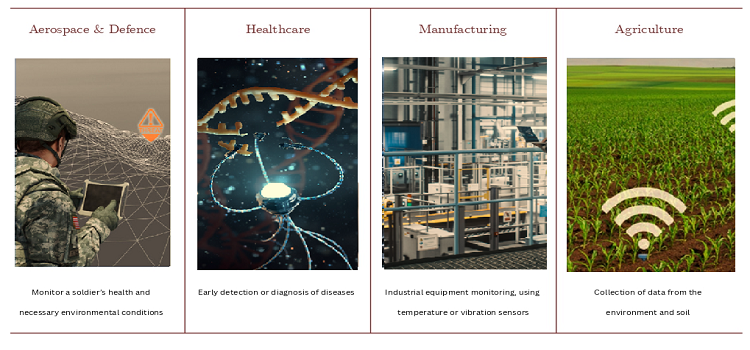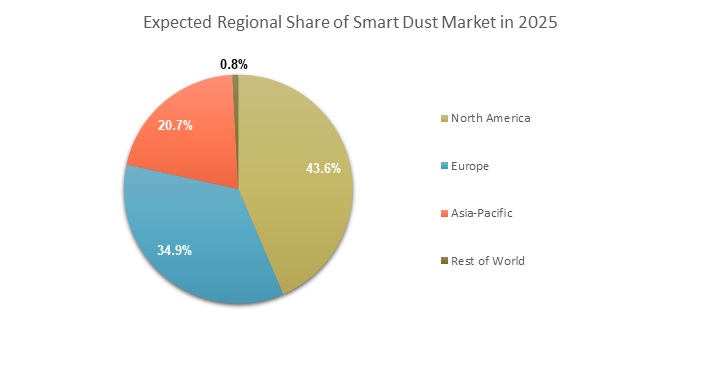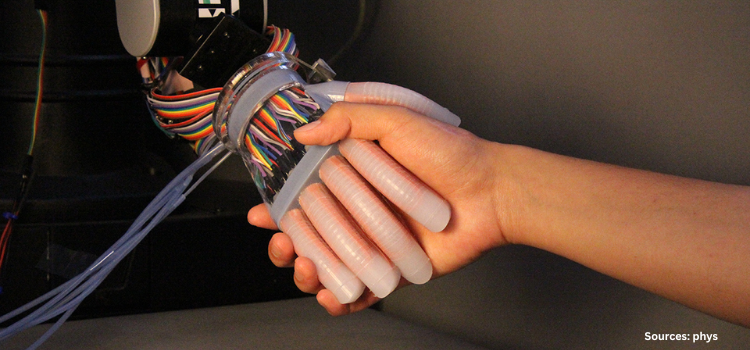Smart Dust: The Future of Sensor Technology
15-Feb-2025

Introduction
Smart Dust is a collection of several microelectromechanical systems (MEMS) such as sensors and other devices that can sense light, temperature, magnetism, vibration, or chemicals, among others. Typical Smart Dust consists of nano-structured silicon sensors, which can autonomously orient, sense, assemble, and report on the environment it is present in. Smart dust has the potential to revolutionize a wide range of industries, from agriculture and environmental monitoring to healthcare and defence.
What can Smart Dust bring to the Aerospace & Defence industry?
Smart Dust is expected to receive widespread adoption across the aerospace and defence sector as it can help monitor a soldier’s health and necessary environmental conditions such as temperature, air, and humidity for safe transport. It also helps access remote or inaccessible areas where unmanned systems or humans can’t reach for search & rescue operations or collect intelligence on enemy movements.
The military & defence sector is conducting extensive R&D activities to lead the development of Smart Dust systems for military applications incorporating unique capabilities such as corrosion sensing, sensing physical properties, and alerting military personals when military vehicles such as tanks or weaponry requires repair.
Moreover, the development of military grade active sensing packages that utilize Smart Dust to detect damage, corrosion, substrate integrity of military infrastructure, military vehicles and equipment is further increasing its adoption.
In addition, Smart Dust is also used to monitor environmental conditions such as radiation, presence of chemicals or gases in the air and temperature for surveillance of the area to ensure its suitability for military troops. To find more data about Smart Dust uses in other industries, visit our website.
Which Region will Dominate the Smart Dust Market?
North America is the leading region globally in terms of the development of Smart Dust at present and is expected to continue its dominance in the upcoming years. This is attributed to factors such as high military expenditure in countries such as US and Canada that enables them to expand R&D activities in advanced technologies such as Smart Dust for numerous military applications such as monitoring battlefield conditions and gathering intelligence. For instance, as of March 2022, the proposed U.S. Department of Defense (DOD) budget for research and development for 2023 is $130.1 billion.
In addition, rapid expansion of industries such as agriculture, healthcare, and manufacturing are further fueling the wide acceptance of Smart Dust in the region. For example, in agriculture, smart dust is being developed to monitor soil conditions, weather patterns, and crop growth in real-time, enabling farmers to make more informed decisions about planting and harvesting.
Also, the development of Smart Dust biosensors that can be injected into the human body for diagnostic purposes is creating new possibilities in the healthcare industry, which in turn could further fuel the growth of the Smart Dust market in future.
Are there any challenges?
Despite its many potential applications, there are also a number of challenges associated with smart dust technology. One of the biggest challenges is the limited battery life of these tiny devices, which can make it difficult to collect and transmit data over extended periods of time. In addition, there are also concerns about the security of the data collected by smart dust, as well as the risk of malicious individuals exploiting the technology for harmful purposes.
Conclusion:
Smart Dust represents a major step forward in the field of wireless sensing and communication, and its potential applications are wide-ranging and exciting. While there are challenges that need to be addressed, the future of smart dust looks bright, and its development and deployment is sure to continue as the technology continues to evolve and improve.
About the Author:
 Shankar Nishant is a researcher at Next Move Strategy Consulting with a cumulative experience of more than four years. He is enthusiastic about new technology and enjoys working with a diverse range of global clients; and has delivered numerous market reports in multiple domains. He can be reached at info@nextmsc.com
Shankar Nishant is a researcher at Next Move Strategy Consulting with a cumulative experience of more than four years. He is enthusiastic about new technology and enjoys working with a diverse range of global clients; and has delivered numerous market reports in multiple domains. He can be reached at info@nextmsc.com
Add Comment
Related Blogs
AI-Powered Tactile Sensors Revolutionizing Industry with Touch
Introduction In the landscape of industrial technology, the integration of ar...
How Technological Advancements in Digital Pen is Reshaping the Market
Introduction As the digital pen market continues to evolv...
Top 5 Trends in Semiconductor Industry
The global semiconductor industry has been evolving and growing steadily. This growth has largely been driven by the soaring deman...












